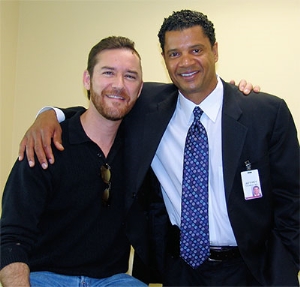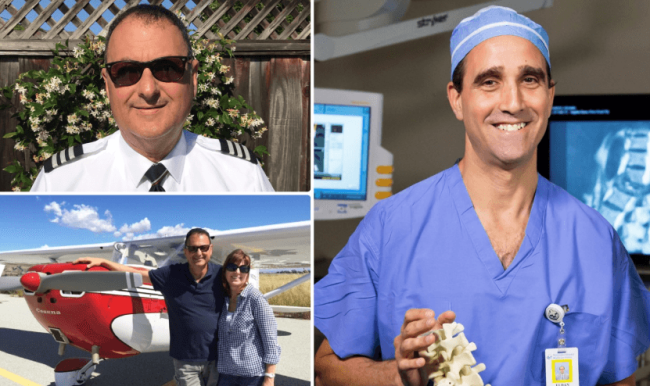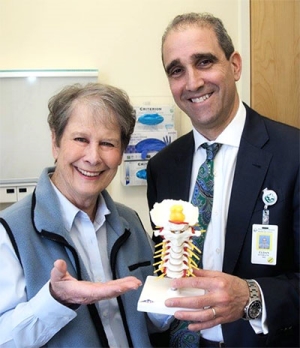
Gamma Knife Surgery®
Introducing the Leksell Gamma Knife® Perfexion™
The ultimate tool for stereotactic radiosurgery is now at Washington Hospital. Find out more below, and through this Washington Hospital publication.
- A revolutionary alternative to traditional surgery and whole brain radiation – highly effective in treating conditions of the brain and head areas
- Performed by a world renowned team of physicians and other medical experts
- Fast, precise and comfortable – PERFEXION™ delivers on the promise of minimally invasive treatment.
The gold standard for treating brain tumors and other serious neurological disorders without an incision. The Leksell Gamma Knife is recognized worldwide as the ultimate tool for noninvasive stereotactic radiosurgery, effectively treating many serious neurological conditions with the utmost patient safety and comfort. Since the first Gamma Knife was introduced forty years ago, hundreds of thousands of patients have experienced improved quality of life with the help of this powerful treatment approach.
Based on a breakthrough in technology, the latest generation Gamma Knife® PERFEXION™ has taken minimally invasive radiosurgery to a completely new level of sophistication and effectiveness while maintaining full clinical compatibility with previously successful procedures and protocols. PERFEXION’s extended treatable reach offers access to unlimited cranial volume and expands anatomical reach. In addition, by optimizing the system’s robotic component, treatment times have been shortened dramatically.
Today, the exceptional benefits and wider application range of advanced Gamma Knife radiosurgery are improving the quality of life for many more patients with serious neurological conditions. Washington Hospital is proud to be the first hospital in the United States to install this powerful, leading edge instrument as the cornerstone of its new Taylor McAdam Bell Neuroscience Institute. Safe, fast and painless outpatient radiosurgery. A major turnaround from traditional treatment approaches. With PERFEXION’s revolutionary new radiosurgical platform, skilled physicians at Washington Hospital can distribute a complex, finely mapped dose of radiation to target tissue more quickly and accurately than ever before. Nearby healthy tissue is left unharmed.
Meanwhile, radiation exposure to other parts of the body is extremely low, making Gamma Knife an excellent treatment tool.
PERFEXION’s unmatched combination of power and precision results in positive clinical outcomes with few complications. The painless treatment is usually done on an outpatient basis and requires no general anesthesia. Most patients are able to return home in just a few hours and resume normal activities within a day of treatment.
One of the World’s Most Skilled, Experienced Surgical Teams
Washington Hospital’s Gamma Knife Program is led by one of the most accomplished teams of specialized physicians, physicists and nurses.
Medical Directors neurosurgeon Sandeep Kunwar, MD, and radiation oncologist David Larson, MD, PhD, are both nationally and internationally recognized for their expertise, innovation and leadership in the field of Gamma Knife radiosurgery. Both board certified physicians, together they have more than 20 years of experience performing thousands of procedures.
Our Team Approach: Collaborating to Provide Patients With the Best Care
Teamwork is essential to the quality and effectiveness of Gamma Knife radiosurgery at Washington Hospital. Specially trained neurosurgeons, radiation oncologists, medical physicists and nurses collaborate to create an individualized treatment plan for each patient and utilize PERFEXION’s sophisticated features to target and treat the condition painlessly and in just a few hours.
Referring physicians are also considered key team members. Our doctors are committed to open communication throughout the process and are also available for follow-up consultation after a patient has been returned to the care of his or her referring doctor.
Our mission is to achieve excellent clinical outcomes while giving patients the best possible experience. That is why we regard the patient as an essential member of the treatment team. We take a comprehensive approach to care, ensuring that everyone who is in touch with the patient – from pre-operative education through post-operative therapy – has an advanced level of training so that the unique needs of people with serious neurological conditions can be met. In fact, our medical teams are strongly influenced by the “Patient First Ethic,” Washington Hospital’s guiding principle which states all decisions and actions must be based on what is best for the patient.
A Quantum Leap in Safety, Speed and Effectiveness
Developed for power and accuracy. With Gamma Knife radiosurgery, the treatment team combines the power of computers and diagnostic imaging with the Gamma Knife’s pre-operative planning and 3-dimensional reference systems to create a detailed map of the pathological area. After a local anesthetic is applied, a frame is affixed to the patient’s head. Then, 192 cobalt-60 gamma ray beams are shot through the system’s portals, converging on the target with a high level of accuracy.
The latest generation Gamma Knife PERFEXION incorporates new technology refining this powerful procedure while expanding its ability to map the radiation dose accurately. In addition, there has been a considerable increase in the number of conditions the Gamma Knife can treat effectively.
Patients experience added comfort due to the PERFEXION’s smaller,
lighter head frame. With the new configuration, they can rest quietly
as the system is adjusted to fit the size and shape of the treatment area.
PERFEXION was developed in collaboration with leading neurosurgeons; physicists;
and radiation oncologists, including David Larson, MD, PhD, co-medical
director of Washington Hospital’s Gamma Knife program.
History of Gamma Knife® Surgery
The Gamma Knife was invented by Swedish physician and Professor of Neurosurgery Lars Leksell. In 1951, collaborating with physicist and radiobiologist Borje Larsson, Leksell developed the concept of radiosurgery. Through this process, Leksell achieved a non-invasive method of destroying discrete anatomical regions within the brain with minimal affect on surrounding tissues. He integrated the concept with a stereotactic approach developed by British scientists, using a three-dimensional coordinate system to locate small targets inside the body.
In 1968, Leksell introduced the first Gamma Knife, a powerful, accurate technology for the treatment of intracranial tumors. Since that time, scientists have extended application of the Gamma Knife to other neurological conditions. To date, more than 400,000 patients around the world have been treated and 2,500 peer-reviewed papers have been written about the procedure, which is widely regarded as the best noninvasive treatment for brain disorders.In 2006, Leksell Gamma Knife manufacturer Elekta introduced a new industry standard for radiosurgery – the Gamma Knife PERFEXION. Based on a revolutionary platform, the PERFEXION is a major leap forward in technology, offering an expanded treatment reach and giving physicians the ability to perform procedures in a fraction of the time.
The New Standard in Noninvasive Treatment
The Leksell Gamma Knife is well known for unsurpassed accuracy and proven
clinical outcomes.
Its integrated approach enables surgeons to localize and treat tumors and
other pathological areas powerfully and precisely while avoiding the difficulties
and pain of traditional surgical treatment and recovery.
Treatment for a Broad Range of Brain-Related Disorders Including:
Malignant Brain Tumors
Diagnoses include astrocytoma, glioblastoma (also known as grade IV astrocytoma) and metastatic brain tumors, including multiple lesions. Treatment of metastatic tumors in the brain offers excellent, long- term control without disrupting systemic chemotherapy. The type and location of the tumor often determine the approach to medical management.
Acoustic Neuroma
Control rates are very high with Gamma Knife. Gamma Knife is an excellent alternative to surgery and other forms of radiation.
Meningioma
Although benign, tumors can recur after surgical excision or radiotherapy. With Gamma Knife treatment, meningiomas can be painlessly cured.
Pituitary Tumors
Benign tumors effecting the pituitary gland can cause infertility, loss of libido, fatigue or result in acromegely or Cushing’s Disease. Gamma Knife is an excellent alternative to surgery or radiotherapy.
Arteriovenous Malformation (AVM)
The Gamma Knife can eliminate AVM, thus preventing the risk of intracerebal hemorrhage.
Trigeminal Neuralgia (TN)
Treatment with the Gamma Knife can help relieve severe, bursting face pain often triggered by routine activities.
Chronic Intractable Pain
When conventional therapy fails, the Gamma Knife can treat intractable pain radiosurgically. In a procedure called cingulotomy, the physician attempts to destroy the area of the brain responsible for transmitting pain signals.
A New Radiosurgical Platform for Procedures in the Brain and Head Region
The Gamma Knife PERFEXION includes six components:
- Radiation unit
- Beam-focusing technology
- Patient couch
- Electric bed system
- Control console
- Planning computer system
To localize and map the target area, the team uses one or more imaging technologies, including CT, MRI, PET, or cerebral angiography, depending on the diagnosis. Washington Hospital has recently expanded and upgraded its imaging services, which are located in the same building as the Neuroscience Institute. State-of-the-art imaging services are readily available to the Gamma Knife treatment team.
Once the target has been mapped and the head frame affixed to the patient’s skull, the Gamma Knife distributes hundreds to thousands of cobalt-60 radiation beams in a finely sculpted dose to the target through the machine’s patented collimator design. Although the cumulative radiation here is very high, each individual beam has low intensity, minimizing the effect on tissue it passes through on the way to the target.
During the procedure, the patient is moved in relation to the beams’ isocenter to optimize the radiation dose based on the shape and size of the target. The Gamma Knife’s extreme precision makes it possible to deliver the radiation dose with minimal risk to healthy tissue.
With PERFEXION’s revolutionary new radiosurgical platform, skilled physicians distribute a complex, finely mapped dose of radiation to diseased tissue more quickly and accurately than ever before.
Powerful Advantages for Patients
Nearly 50,000 patients undergo Gamma Knife surgery every year. In addition to its extreme accuracy, outstanding therapeutic response and documented clinical results, the technology is preferred because of its speed and comfort. Gamma Knife radiosurgery requires no head shaving, incisions or sutures. There is no scarring, and the procedure is relatively painless.
It is usually necessary to treat a condition only once using the Gamma Knife, with the treatment completed in a matter of hours. Patients are given a light anesthetic, generally leaving the Gamma Knife Program the same day. Alternatively, with open surgery, patients can spend up to two weeks in the hospital and months convalescing at home. With Gamma Knife, because no incision is needed, the risk of complications is far lower. Gamma Knife is also an alternative to conventional courses of radiotherapy, which requires daily treatment lasting to two to six weeks.
About the Taylor McAdam Bell Neuroscience Institute
Washington Hospital’s Gamma Knife Center is part of the Taylor McAdam Bell Neuroscience Institute, where world class physicians, technologists, nurses and other professional staff use powerful, leading-edge technologies to treat adults and children with a wide range of neurological diseases and disorders. The Institute focuses on highly effective, less invasive treatment approaches that speed recovery and enable patients to experience improved function and a faster return to normal life.
The Leksell Gamma Knife PERFEXION is the technological cornerstone of the Institute.
Other Important Leading-Edge Programs Within the Institute Include:
Endoscopic Skull Base and Pituitary Center
Surgeons combine the latest generation of endoscopic technology with minimally invasive surgical techniques to make care and recovery for patients with pituitary tumors and skull based pathology faster and easier.
Minimally Invasive Spine Program
Specializing in reconstructive spinal surgery, the program provides high quality, effective treatment for patients with a wide variety of spinal conditions. A team of physician experts achieves optimal outcomes while patients experience shorter, more comfortable recoveries.
Stroke Program
Using leading-edge technology, a coordinated Stroke Team is dedicated to diagnosing and treating strokes utilizing the most current approaches to stroke care. The program not only offers high quality, effective treatment for an acute stroke, it also gives patients, their families, and the community at large the tools necessary to become better informed about how to recognize and prevent strokes.
Movement Disorders Program
The program treats patients with movement disorders such as Parkinson’s disease and essential tremors, giving them an opportunity to improve quality of life. A team of internationally recognized physician experts uses the latest generation of technology to achieve better outcomes including deep brain stimulation.
The Institute’s five programs are staffed by medical teams with extensive, specialized training and experience in their particular area of expertise. Many members are internationally recognized as leaders in their fields. Each team takes a comprehensive approach to care, resulting in excellent medical outcomes that also give patients the best possible experience.
The Neuroscience Institute is named in honor of former Washington Hospital general counsel Taylor McAdam Bell, who lost his courageous battle with a brain tumor in June 2006 at the age of 43. A kind, selfless person who was known for his incredible intellect and wonderful sense of humor. Mr. Bell had a significant impact within the Washington Township Health Care District, as well as the wider community.
Gamma Knife Program Brochure
-
Bell Neuroscience Institute of Silicon Valley Neurosurgery, Neurological Surgery, Radiation Oncology 2500 Mowry Ave
#222
Fremont, CA 94538
(510) 818-1160 More Information




